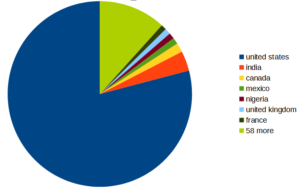
Hello dear readers. I am gobsmacked (in a good way) to see how many have registered for the upcoming series of fifteen webinars about the Patent Cooperation Treaty. (It will be recalled that this webinar series is sponsored by the SLW Institute. If you wish to register for the webinar series, click here.) As of right now the number who have registered is well over one thousand.
The people who have registered come from over sixty countries, and hail from every continent except Antarctica. The pie graph at right shows where some of our registrants come from. More than ¾ of the registrants are from the Americas, which is not a big surprise given that the time of day that I picked for the webinars is a time of day that probably works best for people in the Americas.
Saying this another way, an attendee from Asia or Africa or Australia or Europe will probably need to set an alarm clock or otherwise make pretty exceptional arrangements to be awake and alert and at their desk at the time of day that these webinars will take place.
I offer a bit of reassurance for those who are in Asia or Africa or Australia or Europe. You might be worried that despite your best efforts, you might snooze through one or another of the webinars. What if your alarm clock fails to sound on some particular date when you wanted it to sound? What if your regular daily responsibilities were to make it impossible to be awake on some particular day at the (admittedly very inconvenient) hour of the day of one of these webinars?
The hopefully reassuring bit of news is that our very nice organizers at the SLW Institute will be capturing recordings of each of the webinars. We will work out some kind of routine for posting a raw video recording of each webinar soon after the webinar has taken place. And of course you will have been able to download the presentation materials. This means that if you were to snooze through, say, webinar number 3, you could pick a time to focus on printing out the presentation materials for that webinar, and for watching the recording of webinar number 3, and you could get that done in advance of the live presentation of webinar number 4. In this way you could keep up and hopefully not miss out on important material as we go along.
This is very important because the things we will be learning are cumulative. Each webinar depends on materials that we will cover in previous webinars. Another way to say that is that there will be many webinars that are prerequisites for webinars that follow.
I hope that everybody will be very diligent, carefully marking the times of each of the fifteen webinars in their personal calendars.
We have people attending who come from all of these places and more:
- Albania
- Argentina
- Australia
- Belgium
- Bosnia And Herzegovina
- Brazil
- Bulgaria
- Cambodia
- Cameroon
- Canada
- Chile
- China
- Colombia
- Cote d’Ivoire
- Croatia
- Czech Republic
- Denmark
- Ecuador
- France
- Gambia
- Germany
- Ghana
- Greece
- Hungary
- India
- Indonesia
- Iran
- Ireland
- Israel
- Italy
- Japan
- Jordan
- Kenya
- Kuwait
- Kyrgyzstan
- Mexico
- Netherlands
- Nigeria
- Norway
- Pakistan
- Peru
- Philippines
- Poland
- Portugal
- Qatar
- Romania
- Russian Federation
- Saudi Arabia
- Serbia
- Singapore
- South Africa
- Spain
- Sri Lanka
- Swaziland
- Sweden
- Switzerland
- Syrian Arab Republic
- Taiwan
- Thailand
- Turkey
- Uganda
- United Arab Emirates
- United Kingdom
- United States
- Viet Nam


